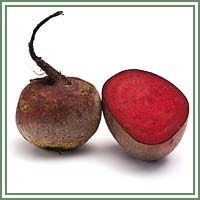BEET
Beta vulgaris
Common name: Beet
Latin name: Beta vulgaris
Family: Chenopodiaceae, goosefoot family
Habitat: Native of South Europe. Domesticated in Mediterranean, and then spread around the globe. There are many cultivated varieties.
Description: Beet is a herbaceous biennial or perennial plant with leafy stems growing to 1-2 m tall. The leaves are glabrous, oval to heart-shaped, 5-20 cm long on wild plants and much larger in cultivated plants, dark green or red. The flowers are small and numerous, produced in dense spikes, 3-5 mm in diameter, green or tinged reddish, with five petals. Flowering usually occurs from June until September. The fruit forms a cluster of hard nut lets. Roots are swollen, globular or cylindrical, deep red color.
Useful constituents: The root contains about a tenth portion of pure sugar, and therefore has a high nutritive value and is a strong source of vitality. Also, Beet root has approximately third of its weight in starch and gum. Roots, herbage and seeds contain vitamins A, B and C.
Medicinal use: Ancient Romans used Beet root as a treatment for fevers and as a laxative. They also introduced Beet root juice as a strong aphrodisiac. From the Middle Ages, Beet root was used as a treatment for illnesses relating to digestive and vascular system. For centuries, the root of Red Beet is used in Europe as a protection against oxidative stress, due to its pigment molecule, betanin. The decoction prepared from the seed is believed to be the remedy for tumors of the intestines, and that the seeds, boiled in water, can help in the process of treating genital tumors. The juice or other parts of the plant are said to help numerous cancer types: leukemia, breast cancer, prostate, rectum, spleen, stomach and uterus cancers. In South Africa, a decoction is used in treatment of hemorrhoids. Beet juice is also an old folk medicine for anemia. In the old days, Beet juice was recommended for anemia and yellow jaundice and, applied into the nostrils it helped clear ringing ears, and soothe toothache. Beet juice in vinegar was also used against dandruff and in prevention of hair loss. Juice of the white beet was said to clear obstructions of the liver and spleen.
Safety: Beet greens are considered to be high Oxalate foods, related to the formation of kidney stones.

